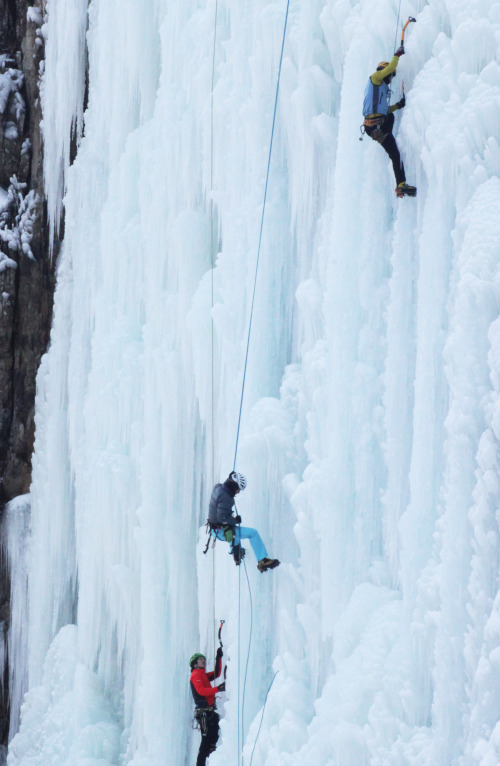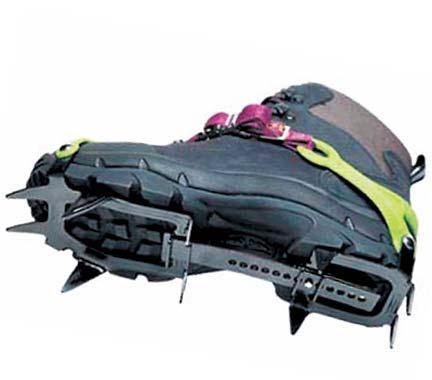
Climbers ascend frozen ice walls at the Yeong Dong Ice Park in North Chungcheong Province on Jan. 8. (Yonhap News)
Winter is at its peak in Korea, and many find it difficult to stay outside. But that’s not the case for a handful of hardcore climbers who scale frozen waterfalls and ice floes.
Most of us wouldn’t want to pull ourselves up slippery ice, but these people try to climb a vertical wall of it in frigid weather and unstable conditions.
“It’s just fun to get out there. Sometimes you have to push yourself to get up to the top, but it’s a lot of fun,” said Peter Jensen-Choi, founder and instructor of Sanirang Alpine Networks.
Jesen-choi, raised in the United States, who made his home here in 1998, has been climbing ice for more than a decade.
We set out on an early Thursday morning, making our trek to Mount Dobong in northern Seoul.
The air felt as if we were around the North Pole as we arrived at the foot of the mountain, but we knew that the ice falls would be in great shape.
After a nearly 30-minute hike over challenging terrain, we arrive at the base of the ice flow.
“It’s time to get our gear up,” Choi said.
With its freezing temperatures and extreme heights, it isn’t a sport for everyone. The psychological aspect, in particular, can be a great barrier to beginners.
But Choi, my instructor for the day, claimed that ice climbing doesn’t have to be difficult and daunting.
“If your safety practices are poor it’s going to be dangerous no matter what. But because you have the axes, secure swing, ice climbing can be really safe, if you go with the right people,” he said.
He told the a story of how two Korean climbers made in 1977 the first ever ascent of Towangsong Falls in Mount Seorak.
It took them more than 10 days to complete the 320-meter-high ice route using only traditional techniques and basic tools.
Today, thanks to advanced tools and techniques, that route is a one-day ascent accessible to many winter climbers here, he said.
Still, because ice climbing is really equipment-intensive, it involves packing a substantial kit.

Ice axe

Crampons
Of them, ice axes and crampons are two must-have tools, according to Choi.
After putting our crampons on, we started the day by practicing some basic foot techniques on relatively flat ice.
“Ice climbing is all about feet,” he said.
Foot technique, Choi said, is an ice climber’s most useful tool and is at the core of overall good climbing.
He first showed the French technique, which is also known as flat-footing. It is basically planting your crampons solidly on ice. All you do is open your feet a little wide and walk up the slope in a duck-like manner. I felt like a baby learning to walk.
“It’s easy, but you must remember all points of your crampons are in the ice,” Choi said while correcting my foot position.
As the slope became too steep to duck-walk, he started to sidestep up the ice.
“Be careful when you are crossing your legs over,” he warned me. But just as he finished the sentence, I lost my balance and fell down on my knees.
“Remember to keep all points of your planted foot in the ice, before moving the other leg.” A lesson learned with nice little bruises on my knees.
Finally, when we approached the almost 20-meter high vertical ice flow, Choi demonstrated how to use the German technique.
To do the German technique, which is also called front-pointing, you have to kick your crampon into the ice and step up. This technique is vital when you ascend vertical ice, Choi explained.
Once you’ve learned the basic foot techniques, then you’re ready to swing the axes, and fully ready to ascend a vertical slope.
At first it wasn’t very difficult to climb up. But as the decline became steep, my feet kept slipping off the slope, and I suddenly felt a chill run down my spine.
“It’s because you kick too high, making it hard to use your foot holds. You must drop your heels to step up with front-pointing,” Choi said.
He also reminded me how important it is to use the axes as an anchor in order to climb up the ice.
“You need to swing it hard to stick deep into the ice, and then pull the planted axes to raise your body up.”
“Try to remember it like a set of dance moves. First left foot, right foot and open then left arm, right arm and up,” he added.
Thanks to his advice, I finally began to ascend the slope, and started enjoying myself.
One of the fun parts was swinging the axe into the solid ice. Although it can be physically demanding, it is exhilarating when the ice breaks up into pieces with every swing.
Choi admitted that it might take some experience and nerve the first time you get out, and it’s often terrifying and painful when you are facing a wall of vertical ice for the first time. But you will feel really special when you achieve an ascent.
“It always feels great when you get up to the top, and the good thing is we can do it with your friends,” Choi said.
For those who are new to the sport and want to learn basic ice climbing techniques, many climbing schools are available. There are over 200 rock and ice climbing areas and several artificial indoor facilities throughout the country. For more information visit Korean Alpine Federation at www.kaf.or.kr/kafmain.
To learn how to climb through reputable climbing schools, also visit Corean Alpine Club at www.cac.or.kr and Kolon Climbing School at www.kolonschool.com.
For English speaking climbing programs, check Sanirang Alpine Networks (www.sanirang.net).
By Oh Kyu-wook (
596story@heraldcorp.com)








